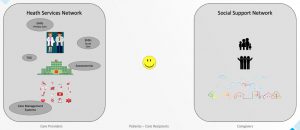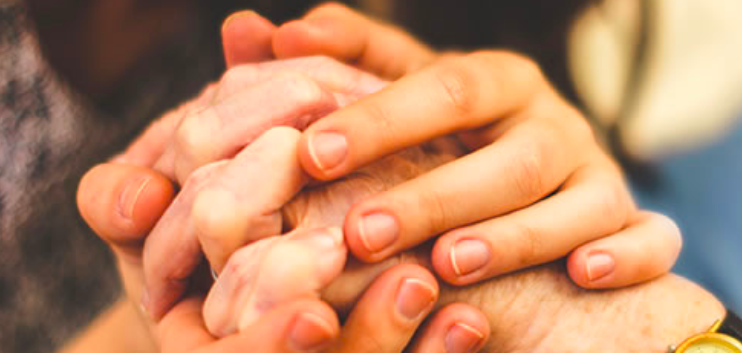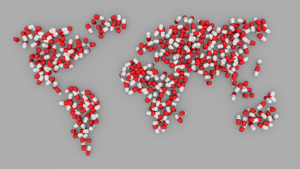With apologies to the Fab Four.
I can do with some help! That’s what I heard again and again from patients that I talked to.
Take the case of Cindy (all names have been changed). She lives alone. Well, not completely alone. She has 3 cats. The pharmacy from where she refills her meds is just down the hill from where she lives, a couple of miles away. She does not have a car, and she gets rides from friends when she gets groceries. Her problem however was refilling her prescriptions. She had to phone a few friends before she could find someone to pick up her refills. She then starting using a popular messaging App. She made a group of friends on this messaging app who had volunteered to pick up her prescription when required. Anytime something needed to be picked up she would send a message to this group, one of them would volunteer, everyone was informed, and Cindy got her meds. Simple.
Folks need help in staying true to their Care Directives. That’s what emerged from my discussions with patients.
Kemp, Quan and Santana in their 2017 study titled “Lack of patient involvement in care decisions and not receiving written discharge instructions are associated with unplanned readmissions up to one year” reinforce these ideas.
Some of the questions that present themselves. What kind of help were they seeking? What kind of help would matter? From whom? Who can help patients?
The providers – doctors, nurses and care managers are who you think of first. But what I also heard of was patients talking about getting help from folks in their daily lives: Relatives – spouse, kids, parents, siblings and friends and well-wishers – the Personal Caregivers.
That reminded me of the patient journey map we had come up with as I had conducted these interviews. We went back and looked at that map. If one looks at the patient journey map from the point of view of the patient this feedback, of getting more help at home, made sense.
When we become unwell, we consult a doctor, or go to a hospital. These interactions may be a few minutes, a few hours or a few days depending on the situation. Our interactions with the healthcare system are well defined and limited in their scope. We have an ‘intervention’ that is generally very brief.
Providers know that the patients need help.  They help patients in many ways. There are some amazing initiatives going on to reach out to patients and give them help as they recover from an illness. The providers have expanded their outreach by adding care advocates, care navigators, call centers, patient portals, providing texting outreach. There are referrals to social services that can provide help to patients on these non-clinical aspects of their care.
They help patients in many ways. There are some amazing initiatives going on to reach out to patients and give them help as they recover from an illness. The providers have expanded their outreach by adding care advocates, care navigators, call centers, patient portals, providing texting outreach. There are referrals to social services that can provide help to patients on these non-clinical aspects of their care.
However, all this still leaves patients wanting. On further questioning it emerged that these efforts are not quite patient centric. They are about the patient but do not invite active participation of patient or the patient’s personal Caregivers.
Let’s look at it from the Patients’ perspective. After these interactions with our Providers, we come back home and live our lives as we nurse ourselves back to health. Home is where we spend most of our time. And home is where we need help. And folks at home are the ones who can help us most.
The 2019 Patient Engagement Survey by Wong and Mohta titled “Why No Single Health Incentive
Works” found that support from family and friends is the most effective method of improving and maintaining health.
Rita’s elderly mom was unwell and needed to be on a special diet for a few weeks. An independent woman, her mom stayed by herself across town about 5 miles away. Rita could cover many of the meals, but not all of them. Her solution for her mom was quite like Cindy’s. She made a group a few friends on a messaging App who had volunteered to provide a few meals. They coordinated their efforts by messaging to the group, and one or the other friend would pick up the slack when there was one.
These initiatives are about the healthcare providers pushing services out to the patients – they are about the patient; but do not involve the patient.
The patients, and their Caregivers both said similar things. That there are people who want to help, and that there are people who need help, however, there is no efficient way of letting people know that help is required, and for people to let others know that they are available to help. This seemed to be a communication problem and not a willingness or availability issue.
I found that even folks living alone often have people that they can ‘lean on’ take help from.
I found that role that Caregivers play can be significantly enhanced if communication between them could be simplified, their efforts coordinated in some way.
Cory is a full time caregiver to his wife. She has been bedridden for a few years. Cory is remarkably cheerful despite his situation. However, he likes some respite now and then just so that he can go for a long walk or to the neighborhood pub to shoot the breeze for a few hours. He finds it difficult to find paid relief reliably. It has become even more complicated with the pandemic. However, he told me that there are many people who would be happy to spell him for a few hours but there is no way to reach out to them when he would like to break away for a bit. He does not want to get on the phone and keep dialing people to find relief. He has been looking for ways to address this problem.
As highlighted by Cory’s situation, Caregiver burnout is a big issue. More often than not, the burden of care, especially for long term and chronic cases, falls on a single individual – a primary Caregiver. And primary Caregivers require Respite care – as with Cory.
As with Patients, so also with Caregivers. Caregivers require support as well. It is clear from talking to many people that an ecosystem is required to support Patients. An active community is the best option.
This pointed to the next question – how can this be done? How can a community be identified, built, leveraged in context of health of a person? I heard some interesting ideas, and I will be sharing them in my blogs.





